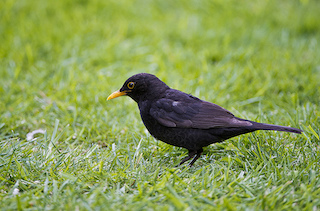 Blackbirds can be seen throughout the year on The Lizard.
Blackbirds can be seen throughout the year on The Lizard.
Photo: © Julian Dowse/Natural England
Scientific name: Turdus merula
Other common names: Common Blackbird, Colly Bird (archaic)
Cornish name: Molgh Du
Conservation status: IUCN Red List, Least Concern; UK Birds of Conservation Concern, Green.
What to look for:
• Colouring and appearance: The males are black with bright yellow beaks and a prominent yellow eye ring, while females are brown with spotted breasts. Juveniles have speckly brown colouring.
• Size: Wingspan 36 cm, length 24 cm.
• Where: Woodland, scrub and gardens across the UK
• Call: Listen here to the Blackbird’s melodious song
 The blackbird may be a common sight across Britain but its song, however familiar it might be, lifts the spirits throughout the spring and summer. A bird originally of woodland habitats, this species is a common garden visitor, where individuals can be observed probing the ground for insects and earthworms to eat.
The blackbird may be a common sight across Britain but its song, however familiar it might be, lifts the spirits throughout the spring and summer. A bird originally of woodland habitats, this species is a common garden visitor, where individuals can be observed probing the ground for insects and earthworms to eat.
This is a mainly solitary species, especially during the breeding season. Male blackbirds establish a territory in late autumn, and the pair defends it rigorously from the breeding season in spring, until the last brood has fledged in summer. Each pair raises between two and three broods, each from three to five eggs, and fourth broods are not unknown in a good year, dependent on the weather. Females are the nest-builders, making their cup-shaped, mud- and grass-lined nests from twigs and other vegetation low to the ground. It is also the females that incubate the eggs and brood the youngsters, but the males help out with feeding, and may take sole care of the fledglings while the female gets ready for the next brood.
Blackbird chicks fledge at about two weeks old, but if the nest is disturbed will leave early, hiding under cover until able to fly. In this way, they are known to survive from as young as nine days. This behaviour has evolved as a means of guarding against predation, although losses are high nonetheless, with 30 to 40% of young eventually fledgling.
Have you ever noticed that there seem to be more Blackbirds around in the winter? While a resident species in Britain, many individuals do migrate from north to south, in search of milder winter temperatures.
Did you know…?
…The modern reference to “four calling birds” in the traditional carol The Twelve Days of Christmas was originally “four colly birds”, an archaic name for the Blackbird.
…Blackbirds are sometimes seen with partial albinism, in which a few feathers are white.
More information and references:
Svensson, L., Mullarney, K., Zetterstrom, D.,1986. Collins Bird Guide, second edition (translated by Christie, D., Svensson, L.). HarperCollins, London.
Published: March 2016
Author: Amanda Scott
Photos: © Natural England/Julian Dowse
